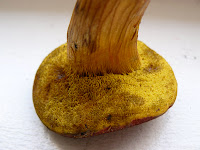 |
| Specimen found on grass |
So here it goes....
Date: 07/17/2011
Location: Rollins Park, Rockville, MD
Habitat: Solitary, growing on grass, under pine trees
 |
| Note that it does not stain |
Pileus diameter - 51 x 46 mm
Pileus height - 17 mm
Stipe lenght - 55 mm
Stipe diameter at apex - 9.6 x 23 mm
Stipe diameter at middle - 9.6 x 16.5 mm
Stipe diameter at base - 9.6 x 11.6 mm
Description
 |
| Pore surface depressing around stipe Tubes are decurrent |
Hymenium - tubes are bright yellow, depressed around the stipe, evenly distributed. Pores are angular and do not bruise. Tubes are around 6.8 mm long and decurrent (go down stipe 4 mm).
Stipe - central, tapered from base to apex, compressed, reticulated (bold brown reticulation)
Spore print - Not obtained
Impressions
This seems to be a Xerocomus spadiceus, also known as Boletus spadiceus Fries. This mushrooms is considered to be a good edible which fruits between July and September under conifers and mixed woods.
Some other possibilities which look very similar are B. illudens and B. subtomentosus. Based on the reference provided below, B. illudens' pileus is described as being pale brownish yellow and becoming yellow-brown to pinkish cinnamon and the pore surface as sometimes bruising weakly blue or blue green (the specimen's pileus had tones of red on the cuticle which do not seem to fit with the description and, in my opinion, the pore surface did not stain). The fact that the pore surface does not stain eliminates B. subtomentosus, which stains greenish blue. Furthermore, B. subtomentosus is described as having a pileus that is olive-ochre and that becomes olive-brown with age. I did not observe any tone of green on the cuticle of this specimen.
Last, depending on how you describe the stipe (i.e. “yellow, bright yellow to golden yellow or yellow orange” versus “pallid, pale yellowish, cinnamon to reddish brown”) a few other similar mushrooms could be considered. For this identification I considered the stipe to be pale yellowish…otherwise I would have to call this bolete Boletus sp.
References
North American Boletes: A Color Guide to Fleshy Pored Mushrooms






No comments:
Post a Comment